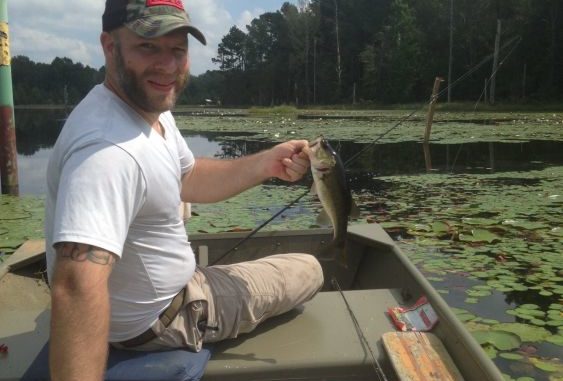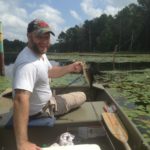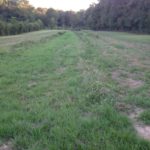
Dry September could mean food plot troubles
Fishing has been around a long time. Heck, several of the disciples were fishermen prior to becoming Fishers of Men.
We are fortunate to live in a state where fishing is open 24/7, all year long. Just look in the pages of Louisiana Sportsman and someone is catching fish somewhere in the state.
Although hunting season is upon us, the month of September was extremely hot and dry. The dove field was ready on the Moreland Estate but there were no doves. Three days of hunting on Labor Day weekend produced a total of 12 birds. I am not certain how the first season went in the rest of the state, but hopefully it was better than what we saw. Consequently, my son Ruffin and I put the shotguns down, loaded up the fishing gear and headed north for our annual father/son fishing retreat.
We were fishing on a family lake in North Louisiana where the fishing is usually good. I had last fished the lake in early June and caught a nice mess of bass on a Ribbit frog and gold Rogue.
We started fishing in mid-afternoon on a smaller lake on the other side of the levee road from the big lake and soon discovered the fishing might be slow. Nothing wanted the frog, and the coontail vegetation in the lake was so thick it was impossible to fish the Rogue or a crankbait. Weedless plastics were going to have to work and we were prepared for this. However, after two hours and only three bass, we dragged over the road to the big lake in hopes it would be better.
It was, but we were working very hard for the fish. Ruffin finally found that a 3-inch Gulp crawfish would work if fished slow and deep. I caught a couple with the Ribbit frog, but it was not what they wanted. I used Ruffin’s bait and caught a fish or two, but had trouble fishing it deep because I had to keep both hands on the paddle. We finished at dark with nine bass, which for this lake was not very good.
The next morning we were fishing at daylight and right off the bat I caught a nice bass with the frog. But the excitement was short-lived, and I basically had to switch from one plastic bait to the next.
The crawfish bait that Ruffin used the day before seemed to work the best, but the key was to fish deep and slow. This lake was full of the coontail vegetation, along with plenty of white water lily, and we did lose a couple of nice fish in the weeds.
I fish with braid on my reels but I have learned that after catching a few bass I need to look at the line and check for frays because the teeth of the bass will weaken the braid.
While the fishing was slow, we did wind up with enough bass for another family fish fry. Ruffin caught twice as many bass as I did, which is what a good guide does — let the client catch the fish. I also wound up cleaning all the fish, which according to my dad, is also what a good guide does.
Many years ago following my freshman year of college, I was spending the summer fishing and playing baseball. The bass fishing had been very good on Lake Bistineau and I invited my grandfather to go fishing. However, he wanted to catch some bream so I put him on a bed of big red eye sunfish (chinquapins) and we loaded up. When we got to the house I asked him how many he wanted and he just said call them when it was time for the fish fry and drove off.
I started the cleaning process and after about 30 minutes dad got home from work. “Now I have some help,” I thought. He walked over and admired the fish, and I asked him if he would help me and he just smiled and with a twinkle in his eye said that a good guide cleans the fish — and he went inside. My position as a fisherman hasn’t changed much: I am still guiding and cleaning all the fish, but that is just fine with me.
While cleaning the bass I checked several of the stomachs and the only food item I found was a 6-inch snake that looked to me like a small cottonmouth based upon the head structure. That’s a bait we didn’t have in our arsenal.
Late season plantings
As I mentioned, September was a hot, dry month. Most people try to have food plots planted by the end of September in time for bow season. When the season opens, i t’s time to hunt and not be on the tractor.
However, in Southeast Louisiana September was the second driest month on record —and planting was just about impossible.
After the first week of the dove season I planted two strips of wheat on the ends of the field, thinking it would be up and growing by the end of the month. Wrong thinking on my part. The seed germinated and was getting some moisture from the morning dew, but overall it was not going to do much. I noticed that the second growth of browntop millet and sunflowers in the field was actually growing well, and by the end of the month the millet had flowered and was producing new seed. Consequently I just left it with the hopes that it might make a decent crop of new seed for the second or third dove split. The only other thing I did to the rest of the plots was just Bush Hog — there wasn’t any need to plow and plant without any soil moisture.
If October continues with the hot and dry weather, then the hunting will have to be in the patches with the jointvetch forage and around any oaks that are dropping acorns. It does seem to be a decent mast crop this year, so that may be the ticket for deer hunters. Planting may not happen until late October or even early November, which is OK. The forage will grow and be available for December and late January hunting, which just might ideal for the late season. Diversify your seed mix with clover and winter grasses. If need be on some patches just mow and sow rye grass, but be sure to fertilize it.
November is the key month for many of the deer areas in the state because the rut is on. Hunt the fronts and be sure to share your harvest through the Hunters for the Hungry Program. There are facilities around the state that will clean your deer, and the meat goes to the various food banks in the area where you live. Check out their website for locations.




